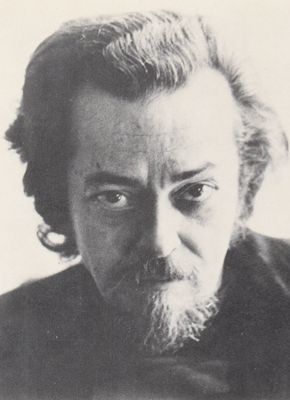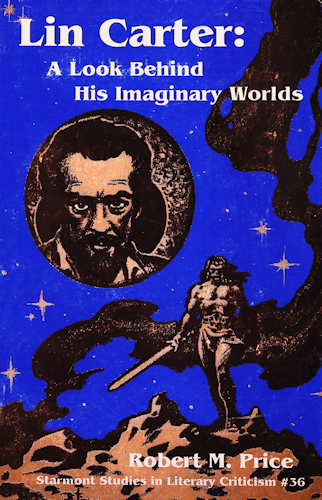Links to Bibliographies
The Big Three
--- Isaac Asimov
--- Arthur C. Clarke
--- Robert A. Heinlein
Lin Carter
--- Introduction
--- Fantasy
--- The Chronicles of Kylix
--- Conan of Cimmeria
--- The Gondwane Epic
--- Tara of the Twilight
--- Terra Magica
--- Thongor of Valkarth
--- Science Fiction
--- Eric Carstairs of Zanthodon
--- The Green Star Saga
--- Hautley Quicksilver
--- History of the Great Imperium
--- Jandar of Callisto
--- The Mysteries of Mars
--- Zarkon, Lord of the Unknown
--- Other Works
--- Other Novels and Collections
--- Charnel House Chapbooks
--- Short Fiction
--- Ballantine Adult Fantasy
--- Flashing Swords!
--- The Year's Best Fantasy Stories
--- Weird Tales
--- Other Anthologies
--- Miscellanea
Science Fiction and Fantasy Series
SF Universes and Fantasy Worlds
A Brief Biography of Lin Carter (1930-1988)
Lin Carter was an American science fiction and fantasy writer, as well as an editor, poet and critic. He is known for his SF and fantasy series including Thongor of Valkarth and Jandor of Callisto, for his adaptions and pastiches of Robert E. Howard's Conan stories, and for his work as editor of the Ballantine Adult Fantasy series and several anthology series.
Linwood Vrooman Carter was born in St. Petersburg, Florida on 9 June 1930. He was an avid reader of science fiction and fantasy in his youth and became knowledgeable in both fields. After serving with the US Infantry in the Korean War, he lived in Hollis, New York and worked as an advertising and publishing copywriter until 1969, when he became a freelance writer and editor.
Carter was a member of the Trap Door Spiders, an all-male literary banqueting club which served as the basis of Isaac Asimov's fictional group of mystery-solvers, the Black Widowers. He was the model for Asimov's character Mario Gonzalo and also created his own team of investigators in Prince Zarkon and his Omega Crew.
Carter was also a member of the Swordsmen and Sorcerers' Guild of America (SAGA), a loose-knit group of heroic fantasy authors founded in the 1960s, some of whose work he anthologized in the Flashing Swords! series. Later, he held gatherings of writers under the aegis of the New Kalem Club - in tribute to H.P. Lovecraft's original Kalem Club - meetings of which were attended by Frank Belknap Long, Robert M. Price and others.
Author
A long-time science-fiction and fantasy fan, Carter's first professional publication was the short story Masters of the Metropolis, co-written with Randall Garrett, and published in The Magazine of Fantasy and Science Fiction in April 1957. Another early collaborative story, this time a parody written with Dave Foley, was published as Uncollected Works by H.P. Lowcraft in the March 1965 issue of F&SF and was a finalist for the 1966 Nebula Award for Best Short Story.
Early in his efforts to establish himself as a writer, Carter gained a mentor in L. Sprague de Camp, who critiqued his novel The Wizard of Lemuria in manuscript. The seventh novel Carter wrote, it was the first to find a publisher, with Ace Books in 1965. Due in large part to their later collaborations, mutual promotion of each other in print, joint membership in both the Trap Door Spiders and SAGA, and complementary scholarly efforts to document the history of fantasy, de Camp is the person with whom Carter is most closely associated as a writer.
Carter was a prolific writer, producing an average of five books a year from 1965 to 1969. He also wrote a nearly monthly column, Our Man in Fandom, in Worlds of If from 1966 to 1968 and was a writer for ABC's Spider-Man animated TV show during its fantasy-oriented second season in 1968-69. He frequently cited his own writings in his non-fiction and almost always included at least one of his own pieces in each of the anthologies he edited. The most extreme instance of his penchant for self-promotion is in the sixth novel in his Callisto sequence, Lankar of Callisto, which features Carter himself as the protagonist.
In most of his fiction, Carter was consciously imitative of the themes, subjects and styles of authors he admired. He usually identified his models in the introductions or afterwords of his novels, as well as in the introductory notes to self-anthologized or collected short stories. His best-known works are his sword and planet and sword and sorcery novels in the tradition of Edgar Rice Burroughs, Robert E. Howard, and James Branch Cabell. His first published book, The Wizard of Lemuria (1965), first of the Thongor of Valkarth serial, combines both influences. His other major series, Jandar of Callisto and Eric Carstairs of Zanthodon, are direct tributes to Burroughs' Barsoom and Pellucidar series respectively.
In other works Carter paid homage to the styles of contemporary pulp magazine authors or their precursors. Some of these, together with Carter's models, include his Simrana Cycle (influenced by Lord Dunsany), his horror stories (set in the Cthulhu Mythos of H.P. Lovecraft), his Green Star Saga (uniting influences from Clark Ashton Smith and Edgar Rice Burroughs), his Mysteries of Mars (patterned on the works of Leigh Brackett), and his Prince Zarkon books (based on the Doc Savage series by Kenneth Robeson). Later in his career Carter assimilated influences from mythology and fairy tales, and even branched out briefly into pornographic fantasy with Tara of the Twilight.
Several series were abandoned before completion. Among these were Thongor of Valkarth, to which Carter intended to add two books dealing with the hero's youth - only a scattering of short stories intended for the volumes appeared and were collected posthumously in Young Thongor. The Gondwane Epic, which he began with the final book and afterwards added several more covering the beginning of the saga, lacks its middle volumes, his publisher having cancelled the series before he managed to fill the gap between. Similarly, his projected Atlantis trilogy was cancelled after the first book (The Black Star), and his five-volume Chronicles of Kylix ended with three volumes published and parts of another (Amalric).
 Some of Carter's most prominent works were what he referred to as "posthumous collaborations" with deceased authors, notably Robert E. Howard and Clark Ashton Smith. He completed a number of Howard's unfinished tales of Kull and Conan the Barbarian, the latter often in collaboration with L. Sprague de Camp. He also collaborated with de Camp on a number of pastiche novels and short stories featuring Conan. The "posthumous collaborations" with Smith were of a different order, usually completely new stories built around title ideas or short fragments found among Smith's notes and jottings. A number of these tales feature Smith's invented book of forbidden lore, The Book of Eibon.
Some of Carter's most prominent works were what he referred to as "posthumous collaborations" with deceased authors, notably Robert E. Howard and Clark Ashton Smith. He completed a number of Howard's unfinished tales of Kull and Conan the Barbarian, the latter often in collaboration with L. Sprague de Camp. He also collaborated with de Camp on a number of pastiche novels and short stories featuring Conan. The "posthumous collaborations" with Smith were of a different order, usually completely new stories built around title ideas or short fragments found among Smith's notes and jottings. A number of these tales feature Smith's invented book of forbidden lore, The Book of Eibon.
Carter wrote numerous stories set in the Cthulhu Mythos of H.P. Lovecraft as well as two cycles of stories paying tribute to Lord Dunsany - Ikranos, during his time as a fan writer, and Simrana, after he became a professional author.
Critic, Historian, Editor and Anthologist
Carter was also known as a critic of contemporary fantasy and a pioneering historian of the genre. His book reviews and surveys of the year's best fantasy fiction appeared regularly in Castle of Frankenstein magazine, continuing in The Year's Best Fantasy Stories. His early studies of the works of J.R.R. Tolkien and H.P. Lovecraft were followed up by the wide-ranging Imaginary Worlds, a study tracing the emergence and development of modern fantasy from the late nineteenth century novels of William Morris through to the 1970s.
His greatest contribution in the field may have been as an editor for Ballantine Books from 1969 to 1974, when Carter brought several then obscure yet important works of fantasy back into print under the Ballantine Adult Fantasy imprint. Authors whose works he revived included Dunsany, Morris, Smith, James Branch Cabell, Hope Mirrlees, and Evangeline Walton. He also helped new authors break into the field, such as Katherine Kurtz, Joy Chant, and Sanders Anne Laubenthal.
Carter was a fantasy anthologist of note, editing a number of new anthologies of classic and contemporary fantasy for Ballantine and other publishers. He also edited several anthology series, including Flashing Swords! from 1973 to 1981, the first six volumes of The Year's Best Fantasy Stories from 1975 to 1980, and an anthology format revival of the classic fantasy magazine Weird Tales from 1980 to 1983.
In his later years, Carter lived in East Orange, New Jersey. He was diagnosed with mouth cancer in 1985, probably a result of his heavy drinking and smoking. Extensive surgery failed to cure the cancer and also left him disfigured. It spread to his throat and lead to his death in Montclair, New Jersey, on 7 February 1988.
Robert M. Price, the editor of Crypt of Cthulhu, who had published a Lin Carter special issue in 1985, was preparing a second tribute edition when Carter died. It was transformed into a memorial issue. Price was also appointed as Carter's literary executor and wrote his biography, Lin Carter: A Look Behind His Imaginary Worlds.
References
- Wikipedia - Lin Carter - retrieved 20 March 2021 - the text above is a revised and reduced version of that found on Wikipedia
- Wikipedia - Lin Carter bibliography - retrieved 20 March 2021
- Wikipedia - Ballantine Adult Fantasy series - retrieved 4 April 2021
- The Encyclopedia of Science Fiction - Lin Carter - retrieved 20 March 2021
- The Haunted Bibliophile - The Ballantine Adult Fantasy Series - rretrieved 4 April 2021
- The Internet Speculative Fiction Database - Lin Carter - Summary Bibliography - retrieved 20 March 2021
- The Internet Speculative Fiction Database - Ballantine Adult Fantasy - retrieved 4 April 2021
An illustrated bibliography is in preparation:



